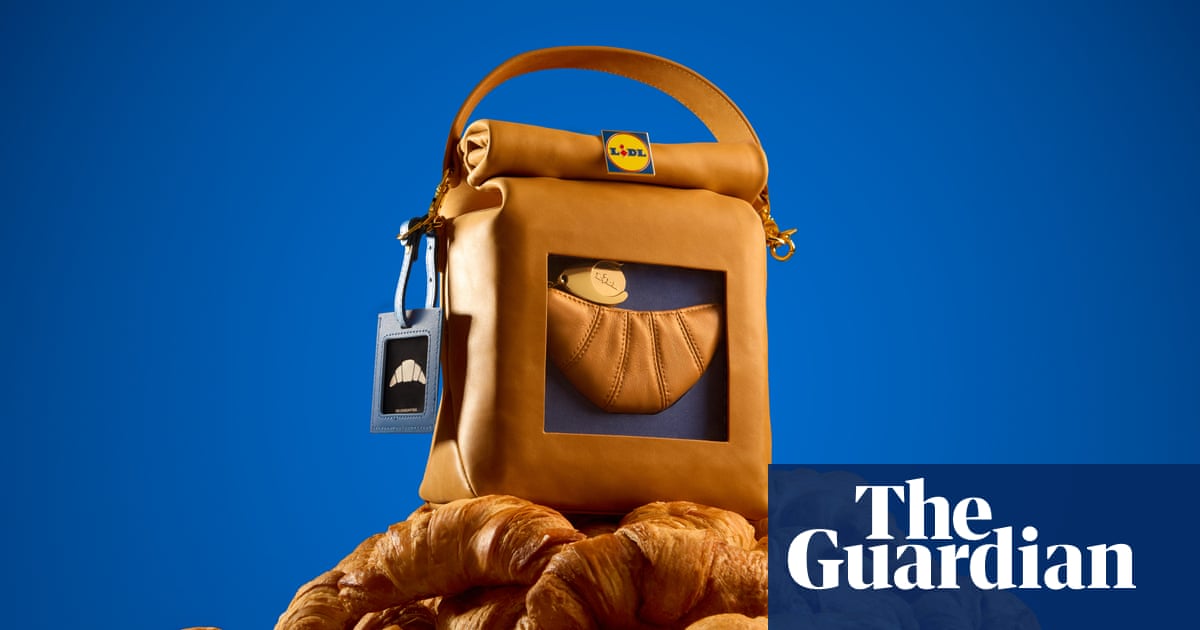Have you ever felt more stylish than when popping out for a pint of semi-skimmed milk? No? Well, that is surprising – because supermarkets and their produce are one of fashion’s greatest muses. This week, Moschino launched its Sedano bag – a celery-shaped clutch that first appeared on catwalks earlier in the year. In response, the UK supermarket, Aldi touted its 75p celery sticks as a cheaper alternative to the $4,470 (£3,730) leather purse, posting a photo on Facebook with the caption: “Your move Moschino, but we do have a whole veg aisle.”
Earlier this year, artist and designer Nikolas Bentel’s £50 croissant bag, inspired by Lidl’s all-butter pastry, sold out. Leather, with a coin purse (and a Lidl-branded trolley coin in the zipper), the paper-bag-style handbag featured a roll-top – as if freshly scrunched en route to the checkout. Last year, JW Anderson, whose designs are a favourite on red carpets, sent a model down the catwalk in a dress seemingly made of Tesco carrier bags. In fact, T-shirts riffing on the Tesco logo, on which the supermarket’s name is replaced with the word “Disco” or “Techno”, seem to hold timeless appeal.
Supermarket staples and fast-moving consumer goods are also often used as inspiration. Bentel previously designed a penne pasta bag seemingly inspired by Italian brand De Cecco’s yellow and blue packaging, which is usually found on grocery store shelves between the own-brand macaroni and the Napolina fusilli. Anya Hindmarch has tapped the cereal aisle with an embellished Frosties bag, as well as the biscuit section via McVitie’s Digestives and Rich Tea clutches, all on sale for roughly £1,300 more than the food that inspired them. At its most recent show, Moschino, a brand that often toys with the iconography of pop culture food brands – perhaps most notably the golden arches of McDonald’s – sent a model down the catwalk clutching a bag resembling a bottle of laundry detergent. Paper grocery bags have been appropriated by everyone from Jil Sander to Bottega Veneta.
So what is behind fashion’s obsession with Tesco et al? Are these seemingly incongruous designs made to go viral? Or do they seek to poke fun at the mundanity of the “big shop”? “Supermarkets are visually appealing with stocked shelves, colourful packaging and endless offerings to satisfy our tastes,” says Melissa Marra-Alvarez, curator of education and research at the Museum at FIT in New York City, and co-editor of Food and Fashion. “There is a lot of material here – literal, figural, psychological – for designers to have some fun and get creative with.”
“Supermarket fashion allows for a very literal presentation of our ‘tastes’ … Food and fashion are both very connected to our personal identity,” she adds. Much like our wardrobes, our shopping lists can be seen to convey who we are, what we stand for and how we want others to view us. Wearing these kind of designs could be seen as an attempt to signal a sort of salt of the earth mentality, despite being able to afford to spend a grand on a bag with Tony the Tiger on it. Dr Gaby Harris, lecturer in fashion cultures at Manchester Metropolitan University, says: “We can see this as a playful relationship between ideas of excess and everydayness.”
There is a more serious side to it all, however. “I think we shouldn’t underestimate the real consequences of this consumer culture,” Harris says, “which privileges wealthy and elite groups to perform an ordinariness, all the while benefiting from a system that sees those from lower income backgrounds unable to afford basic necessities.”
Trends analyst Sabrina Faramarzi agrees that luxury fashion has “always been fascinated with fetishising the value of the mundane”. She cites Chanel’s 2014 show, held in a fake supermarket, complete with Chanel-themed flour, oil and eggs. As the Guardian pointed out: “Not everyone is a fan of high fashion parodying the low, deeming the idea that a customer at Chanel is more likely to carry a Chanel basket than an Asda one a bit off-key, a little Marie Antoinette.”
Faramarzi says: “In my opinion, what was once seen as novel and playful irony now leaves a bad taste in your mouth, especially against the backdrop of an increasingly turbulent economic and social landscape.”
after newsletter promotion
Even so, Marra-Alvarez points out that food motifs have appeared on clothing for centuries. While the depictions themselves may have evolved along with consumer culture, they have long signalled an aspirational lifestyle – and perhaps a carton of detergent is more relatable for most than, say, a lobster-charm pendant. “The appeal of food, both aesthetic and symbolic, to highlight harvest, bounty, abundance or luxury is not a new concept – these associations have always been there.” Her personal favourite? “Rachel Antonoff’s coffee cup sweater” – described on the Antonoff website as “everyone’s favorite bodega beverage”.
To read the complete version of this newsletter – complete with this week’s trending topics in The Measure and your wardrobe dilemmas solved – subscribe to receive Fashion Statement in your inbox every Thursday.











